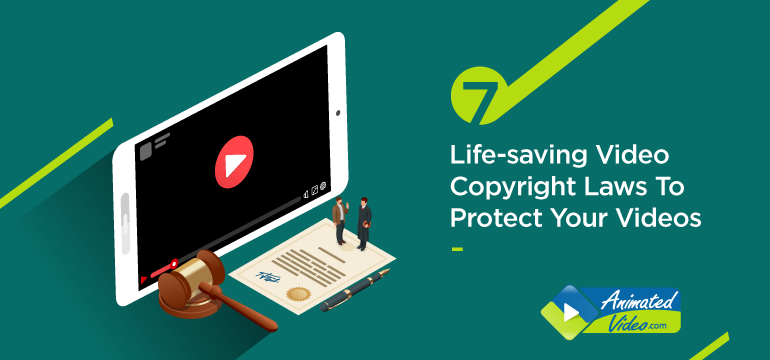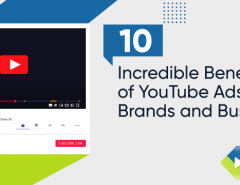Last Updated on April 13, 2022
Video Copyright Laws – What You Should Know About?
Today in this digital era when it’s extremely easy for others to copy your work, you are sure to get devastated. Isn’t it? What do you do to protect your videos?
Don’t worry there are YouTube copyright rules to protect your videos.
Copyright is a form of intellectual property law that protects any original works of the creator for a set period. The law grants you, the copyright owner an exclusive right to control how your work will be used and who can make money from it. This protection law also allows you to determine who can share it on YouTube. Video copyright laws fall under federal law.
Learn about the 7 Life-saving Video Copyright Laws To Protect Your Videos:
1. Copyright infringement
The act of using or producing of copyright-protected material without the creator’s permission is termed as Copyright Infringement. In other words, infringement occurs when a third party breaches any produced/creative work of the copyright holder and publishes/uses it as his/her own.
According to the YouTube copyright infringement laws, if a person is found liable for copyright infringement, he/she may have to face damages of up to $150,000. The law also determines that if the court finds the infringement action willful, then the penalty is even higher.
2. Legal Sound Bites
We can’t deny the importance of sound in videos. A video is not complete without the appropriate use of sounds (music or any voice-over). So, everybody is always in search of suitable audio for their productions. Interestingly, as the internet provides a vast collection of different types of clips, sound effects, etc. and it’s really tempting to use these materials readily available. Nevertheless, it is always easy to fall into the trap of infringing someone else’s copyright also. People doing so will be liable for violating copyright law. So, there’s nothing to worry about your produced audio.
However, you too should be well aware of audio copyright violation. Always focus on creating your audio. But sometimes it becomes extremely difficult to create your own sound bites such as music and sound effects, in this regard you can hire someone to create it for you. Moreover, if you are using audio from someone’s property, it’s advisable to obtain a license to use the audio before merging it into your video. There are other options too – you can think of using buyout music also (it requires a one-time fee for unlimited use).
3. Stills and Images
Similar to the audio copyright laws there are rules of using other people’s stills or images as well. While using video clips or photos created by others, one must get permission from the owner as well as from others who have also contributed to the work.
However, it’s always recommended that one should create images and stills themselves to keep themselves out of any reputational risk.
4. Fair Use Video Clips
Amongst several video copyright laws, there is a provision of ‘Fair Use.’
What is fair use?
According to the concept of Fair use – a person can re-use any copyright-protected material under specific situations without the permission from the copyright owner. It’s interesting to note that different countries have a different set of guidelines for fair use.
In the United States, works of commentary, research, criticism, teaching or news reporting are considered fair use, whereas there are some other countries that have a similar idea called fair dealing that work in a separate scope.
Courts analyze potential fair uses depending on the facts of each specific case. However, the fair use concept is a little tricky because sometimes the copyright owner might disagree with the use and which eventually may lead to facing a lawsuit and consequent damages.
Are YouTube videos copyrighted?
To determine whether the use made of a work is fair use or not take a look at the following factors:
- purpose and character of the use
- nature of the copyrighted work
- the amount used in relation to the copyrighted work and
- the effect of the use upon the market or value of the copyrighted work.
5. Copyright Notice
One of the easiest ways to protect your videos from getting copied is putting up copyright notice- for example © Your Name (year). Through this notice, you can let the public know that you own a particular video. Remember to include the note close to the beginning of the video or at the end. Don’t forget to add this notice on DVD labels or packaging that contains your video.
6. Process of Registration
There are several laws to protect our YouTube videos. Put YouTube copyright disclaimer. According to the rule, the most useful step for protecting your video you need to register your final work in the U.S. Copyright Office (www.copyright.gov). This action of yours will prevent others from copying your valuable work without your permission. You will be satisfied to know that registration is a simple and relatively inexpensive process.
Although many countries don’t give much emphasis on copyright registration, yet there are other countries where you may register your copyright to document your ownership.
7. Content ID Match
Another significant step to prevent your videos from getting copied is to take the benefit of the content ID match system. This is a wonderful step by YouTube.
According to this, the giant video publishing platform automatically matches content that breaches copyright laws against the millions and millions of videos uploaded every month to the site.
The process is quite simple- copyright owners have to upload reference files (original versions of their work) to prove they own the rights.
Needless to say, content ID match eases the tension of any video creator because every new video uploaded to YouTube undergoes a checking process against their vast library of reference files, and if there is a match, YouTube automatically launches a YouTube copyright claim for the owner of the work.
Protect Your Videos
Copyright laws depend on several things, for example when the video was created, whether the video was published or not, what’s the date of first publication and what’s the creator’s time of death. Take the note that copyright protection lasts for your life and an additional 70 years. However, if the work is anonymous, the term is shorter of 95 years from publication or 120 years from creation. So, if you understand all the copyright laws mentioned above, it will be easier for you to implement those and protect your works. In addition to that, you can also avoid falling into the trap.
Create awesome videos with the help of animatedvideo.com and protect them from getting copied.




